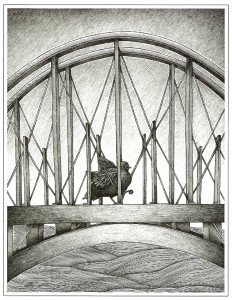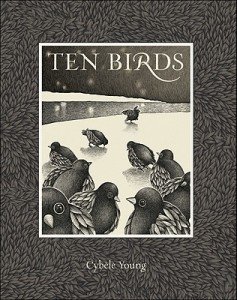Here’s a book that’s got it all: beautiful illustrations, wonderfully inventive text, and pigeons. Or at least I think they’re pigeons. Plumper than pigeons perhaps, and lovelier, but the eyes are quintessential squab. Don’t get me wrong, I love pigeons, just not on my bird feeder. Cybèle Young’s pigeon-like birds, on the other hand, would be welcome at my feeder at any time. Not that they would ever get there of course, at least not before all the seeds had been consumed by the sparrows and nuthatches. Faced with the dilemma of having to get to the other side of the river, ten birds devise ten unique methods of negotiating the gap. It’s not so much a case of why did the chicken (pigeon) cross the road, but how. And I can promise you one thing: these birds think out of the box. Way out out of the box.
On a starlit night, ten birds happen upon a scattering of mysterious numerical structures next to the river they wish to cross. Each of the birds has a name, or at least a reputation. The one they call ‘Brilliant’ disassembles a wooden structure and builds a pair of stilts, which he uses to cross the bridge, leaving nine birds behind. ‘Quite Advanced’ engineers a sort of water unicycle, and paddles her way to the other side of the river. And so on, until all ten have crossed. The vehicles are elaborate, and almost surreal in their visual realization. Call me a linear thinker, but these are birds after all, and I have to wonder why they just don’t fly to their destination. On the other hand, the birds are delightfully roly-poly, with beautiful, decorative wings, so perhaps their physiology has rendered them flightless, although the final scene would suggest otherwise. In any case, it is left to the last bird to make the common-sense choice. ‘Needs Improvement’, being a clear-headed pragmatist in a flock of avian artistes, simply walks across the bridge. Not everyone needs a fancy ride.
The book is organized into double-page scenes with the numbered structure on the left side, and the re-built ‘vehicle’ in action on the opposite page. The larger right-side panels are printed on a cream background, and in combination with the contrasting black ink and the varying weights of the marks, the illustrations take on an etched look, like a collection of prints. Bold lines, interweaving patterns and sparse backgrounds are reminiscent of Van Allsburg’s Two Bad Ants, but I also see the architectural influence of David MacCaulay, and maybe even a little Mahendra Singh, another superbly talented illustrator (and surrealist) in Young’s work. But these are hints only; Cybèle Young’s illustrations are entirely original, and almost European in their exquisite strangeness. And yet, the pigeons, if this is what they are, peck at the ground and twist their bodies in familiar pigeon-like ways, establishing a level of reality in an otherwise fanciful story. For a moment, I found myself wondering if this particular breed of bird might be smarter than I previously imagined or observed, although I suspect that if I left an unassembled IKEA wall unit on the deck just to see what would happen, the response would be more Pollock than Young.
Ten Birds is an imaginative counting book that is both instructive and exquisitely illustrated. A book, in other words, that appeals to parents looking for creative ways to teach their kid about numbers, but also to people like me, who collect books for the art. ABC’s and 123’s are the building blocks of communication, and the conveyance of this basic information has been the inspiration for some of the most gorgeous picture books ever produced. It is a wide open canvas, and Cybèle Young has taken numbers 1-through-10 to places that are truly odd, but also terribly funny and spectacularly beautiful.
A graduate of the Ontario College of Art & Design, Cybèle Young is a Toronto-based sculptor and illustrator, with emphasis on the sculpting. Her delicate, miniature sculptural works are made from fine Japanese papers often printed from etched copperplates. They are really very lovely, but…have you seen her birds? Incredibly, she spent 15 years working on Ten Birds, inspired by ‘the antics of her baby girl’, who must be very clever indeed. In 2000, she was nominated for a Governor General’s Award for Pa’s Harvest (Jan Andrews, Groundwood Books), and I am confident that she will be nominated again, and win, for Ten Birds.
Ten Birds by Cybèle Young. Published by Kids Can Press, 2011. ISBN: 978-1554535682 A big thanks to Kids Can Press for sending me a review copy!





